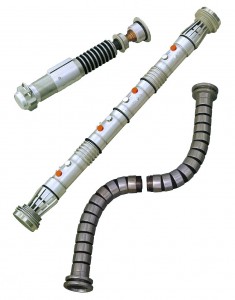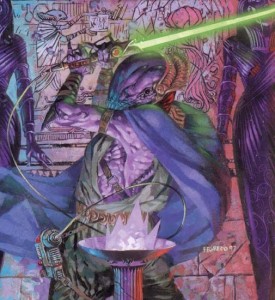TOR Lore: Lightsabers
There are not many items that scream Star Wars more than a lightsaber. The mere sight of one can induce feelings of nostalgia and recognition in any Star Wars fan in a way that few other things can. Though in its original conception it was intended to be a weapon used by many different people in the Star Wars universe, it eventually became a tool that could only be utilized by Force Sensitive beings. To a Jedi, a lightsaber is a tool, something to help them maintain peace and to measure their attunement to the Force. For the Sith, it is a weapon, a way to impose their will on others and to serve as a symbol of their strength and superiority. The mere sight of one can stop a conflict before it begins, and those who have witnessed one in action can speak of the lightsaber’s ability to inspire allies, or cause a sense of dread in opponents. But how were these weapons first conceived, and how do they even work? I will answer these questions for you in this week’s edition of TOR Lore.
When individuals first began to study the Force there were no such things as lightsabers. Back then, ancient followers of the Light Side, and eventually the Dark Side, imbued the Force into regular swords that they would then use in combat and training. These weapons, with the Force running through them, could do more damage in combat than a regular blade. When lightsabers were eventually invented, this technique would even allow the blade to deflect the blows of a lightsaber. In fact, some Sith continued using Force imbued swords as they preferred the feel of the metal blade cutting through flesh.
The next step to developing fully functioning lightsabers was the invention of something known as a protosaber. Like a regular lightsaber, this weapon used a crystal set in a hilt to emit a blade of energy, but the big difference in protosabers was that they had an external power source. The user wore an external power pack on their hip that attached to hilt via a chord that powered the weapon. While they were considered an improvement over the Force swords of old, the weapon suffered from several limitations. First of all, it had a limited power supply, and it could power down in battle if the pack was not recharged regularly. Secondly, they lacked mobility due to the chord that connected the power pack to the hilt itself. Because of these limitations, there were some Jedi and Sith that continued to use the more traditional Force powered weapons, but the protosaber was a huge leap forward in technology that would lead to the lightsabers that we know today.
As power cells grew more powerful, yet smaller, they could be incorporated into the design of the lightsaber hilt itself, leading to the invention of the modern lightsaber. It was the Sith Empire that first developed the modern lightsaber, though the Jedi quickly adopted this technology once they discovered it. Modern lightsaber hilts were often between 20 and 35 centimeters in length, though this could change depending on the user’s preferences. Though they were unique to the wielder, they all contained a few parts that were necessary for the blade to function, the most well known being the crystal. Contained within the blade, usually imbued with the Force much like the old swords, these crystals were often found in caves that were strongly influenced by the Force. However, it is possible to artificially create crystals that can be used in lightsabers as well. These types of crystals are commonly used by the Sith, who had often been cut off from crystal caves while in exile, though some Jedi have made use of them as well. Eventually, the Sith came to see these artificial crystals as superior and began to forego the use of naturally occurring crystals entirely. Other than the crystal99999, all lightsabers contain a power cell, focusing lens, emitter matrix, power insulator, pommel cap, and blade emitter. These parts generated the necessary energy, focused it through the crystal, and converted it into superheated plasma. This plasma is then contained in an electromagnetic field that protects the user from the immense heat and energy that the plasma gives off. Most, but not all, lightsabers have a function that allows the wielder to manipulate this field, shortening or lengthening the blade as they see fit. This plasma is so hot and powerful that it can cut through most materials in the known universe, and will instantly cauterize wounds when fighting organic opponents.
Because of the unique design of the lightsaber and the properties of the blade, all of the weight of a lightsaber is contained in the hilt. This makes determining the location of the blade difficult without the aide of the Force. This, combined with the internal gyroscopic effect created when the blade was activated, is why the weapon can only be used to its full potential in the hands of a Force Sensitive. Without the aide of the Force, the blade is difficult to wield, and without using the Force to enhance their senses, it is very easy for an untrained user to sever their own limbs. In addition, in order to block blaster bolts or engage in lightsaber combat, the user needs to be able to enhance their movement speed and spatial awareness through the Force. Without the ability to use the Force, the lightsaber is often more of a liability in combat than anything, which is why you don’t see them being used by anyone other than Force Sensitive beings. Even in this case, it often takes years of practice to master lightsaber combat to a level where it will be useful in battle. Because of this, Force Sensitives who were training in lightsaber combat often used training lightsabers that could not sever flesh but would often leave burns a welts when they came in contact with flesh. Some would even cause paralysis in limbs to simulate them being severed by the blade in combat.
The blade itself is a mass-less form that does not expend heat or energy until it comes in contact with something solid. Its power is so great that it can cut through almost anything, though the speed with which it cuts depends on the density of the object and the force the user puts behind their blade. When cutting through dense material, the blade’s containment field can cause resistance rather than let the matter pass through the blade, giving the blade a feeling of being solid. The blade itself can repel energy fields and coherent energy, such as blaster bolts, force fields, and other lightsabers. There are also some lightsaber-resistant materials that can repel the blade with varying degrees of success. Arguably the most successful is Cortosis, which, in its pure form, can actually cause a lightsaber to short out for a brief period of time. It’s pure form is quite rare though, so a refined form of the metal is often used in armor and swords to allow them to resist lightsabers and give non Force users a way to combat lightsabers. Other lightsaber resistant materials include Phrik and Mandalorian Iron, rare metals that the blades cannot cut through. Lightsabers always short out when submerged in water, due to rapid chain reactions and the instant overpowering of water on the blade. Special construction can allow the blade to remain ignited while submerged, but the process is quite complicated so most Force users do not bother unless they are members of an underwater species.
Besides the traditional lightsaber, there are several other designs that have been employed by Sith and Jedi alike. Probably the most recognized alternate version would be the double-bladed lightsaber, sometimes referred to as a saberstaff. This design’s hilt is generally double the size of a regular blade in order to compensate for the extra materials required to make it work, and can deploy one or both of its blades as the user sees fit. Another common design is the shoto, or short lightsaber. This style of blade is often employed by warriors in their off hand when using a dual blade style. Force users of a smaller stature, such as Yoda, usually employ a blade of this size as their main weapon. There are also several other versions that are much more uncommon, such as a lightwhip, lightclub, lightsaber pike, and sabercane. Most of these differ from the more traditional lightsabers in the size of their hilts and blades, though the lightwhip’s blade is much more flexible, allowing it to be employed like a traditional whip. No matter the style of lightsaber being used, they all require a considerable amount of training and skill to be used effectively in combat.
Serving as the symbol of the Jedi and the Sith, the lightsaber is one of the most beloved creations to come out of the Star Wars universe. I know I’m not the only one who as a kid, and an adult, imagined wielding one of these legendary weapons in imaginary battles. Whether you view them as a tool like the Jedi do, or a weapon as the Sith do, we can all appreciate the symbolism that these objects represent. Next week I will be taking a look at the most practical, and exciting, application of the lightsaber: the seven forms of lightsaber combat.
One Response to “TOR Lore: Lightsabers”









Awesome article !